Reflection Paper: Community Volunteer Project Analysis, CCC
VerifiedAdded on 2020/04/07
|5
|936
|471
Report
AI Summary
This reflection paper analyzes a community volunteer project at a drug rehabilitation center, focusing on youth and young adults. The paper addresses the role of the volunteer, the vulnerable group served, and the risk factors associated with substance abuse, including aggressive behavior, lack of parental supervision, peer pressure, drug availability, and poverty. It explores health promotion strategies aimed at reducing drug supply, demand, and harm, while also strengthening the well-being of those using drugs. The report highlights the importance of early screening, counseling, and prevention strategies involving the individual, family, and community. The author learned about the widespread nature of drug abuse, the impact of various substances, and the effectiveness of comprehensive health promotion approaches. References from SAMHSA, NIDA, CCSA, CDC, Healthy People 2020, and Merikangas & McClair are included.
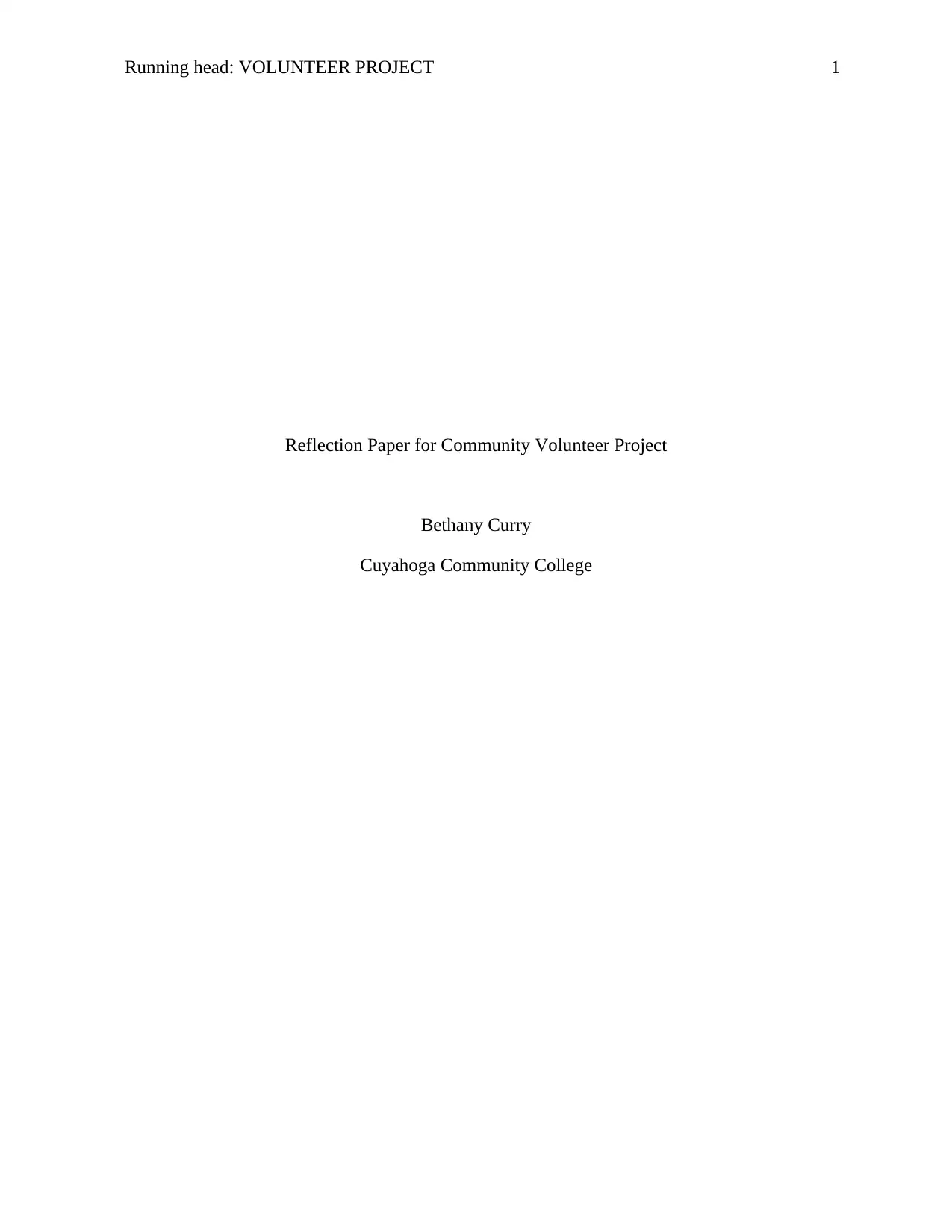
Running head: VOLUNTEER PROJECT 1
Reflection Paper for Community Volunteer Project
Bethany Curry
Cuyahoga Community College
Reflection Paper for Community Volunteer Project
Bethany Curry
Cuyahoga Community College
Paraphrase This Document
Need a fresh take? Get an instant paraphrase of this document with our AI Paraphraser
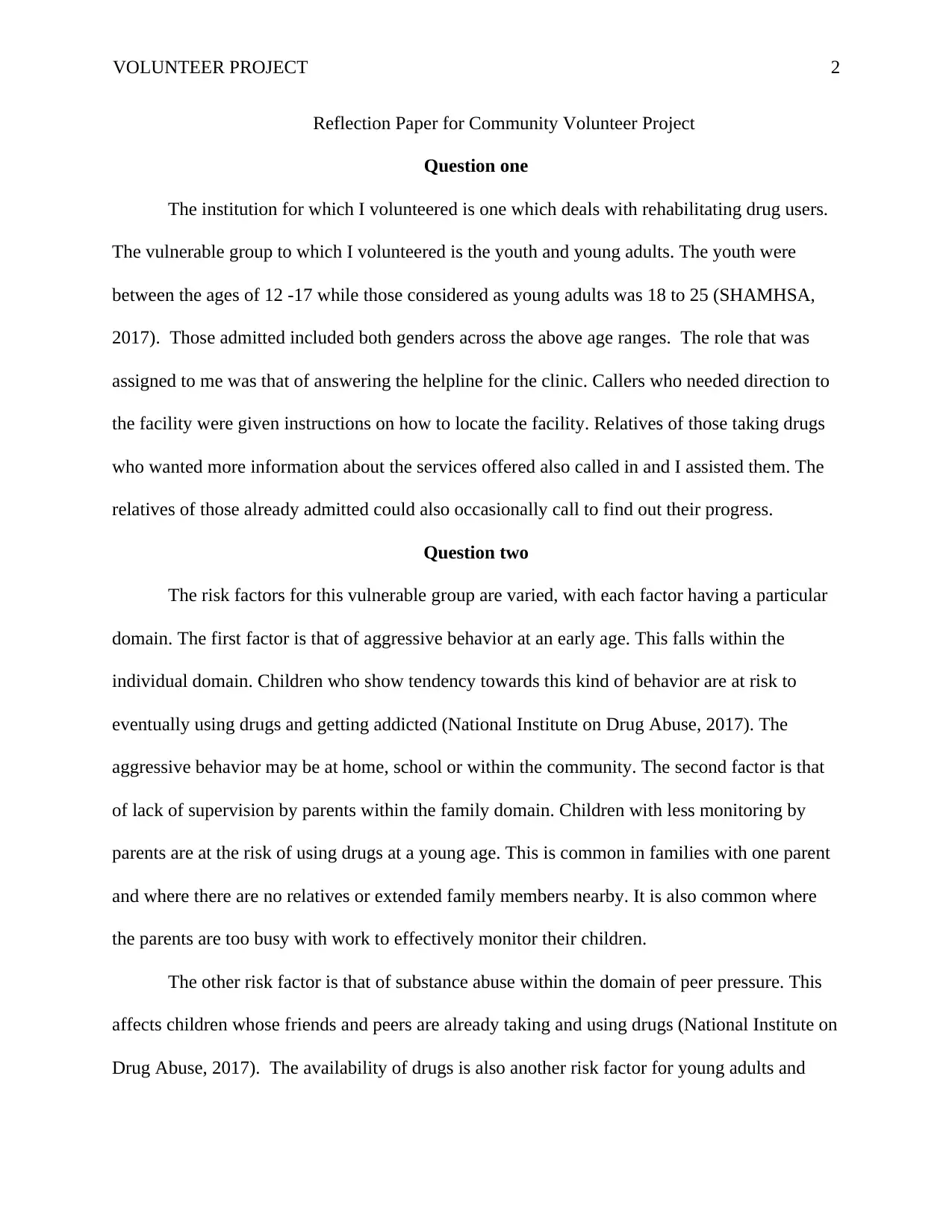
VOLUNTEER PROJECT 2
Reflection Paper for Community Volunteer Project
Question one
The institution for which I volunteered is one which deals with rehabilitating drug users.
The vulnerable group to which I volunteered is the youth and young adults. The youth were
between the ages of 12 -17 while those considered as young adults was 18 to 25 (SHAMHSA,
2017). Those admitted included both genders across the above age ranges. The role that was
assigned to me was that of answering the helpline for the clinic. Callers who needed direction to
the facility were given instructions on how to locate the facility. Relatives of those taking drugs
who wanted more information about the services offered also called in and I assisted them. The
relatives of those already admitted could also occasionally call to find out their progress.
Question two
The risk factors for this vulnerable group are varied, with each factor having a particular
domain. The first factor is that of aggressive behavior at an early age. This falls within the
individual domain. Children who show tendency towards this kind of behavior are at risk to
eventually using drugs and getting addicted (National Institute on Drug Abuse, 2017). The
aggressive behavior may be at home, school or within the community. The second factor is that
of lack of supervision by parents within the family domain. Children with less monitoring by
parents are at the risk of using drugs at a young age. This is common in families with one parent
and where there are no relatives or extended family members nearby. It is also common where
the parents are too busy with work to effectively monitor their children.
The other risk factor is that of substance abuse within the domain of peer pressure. This
affects children whose friends and peers are already taking and using drugs (National Institute on
Drug Abuse, 2017). The availability of drugs is also another risk factor for young adults and
Reflection Paper for Community Volunteer Project
Question one
The institution for which I volunteered is one which deals with rehabilitating drug users.
The vulnerable group to which I volunteered is the youth and young adults. The youth were
between the ages of 12 -17 while those considered as young adults was 18 to 25 (SHAMHSA,
2017). Those admitted included both genders across the above age ranges. The role that was
assigned to me was that of answering the helpline for the clinic. Callers who needed direction to
the facility were given instructions on how to locate the facility. Relatives of those taking drugs
who wanted more information about the services offered also called in and I assisted them. The
relatives of those already admitted could also occasionally call to find out their progress.
Question two
The risk factors for this vulnerable group are varied, with each factor having a particular
domain. The first factor is that of aggressive behavior at an early age. This falls within the
individual domain. Children who show tendency towards this kind of behavior are at risk to
eventually using drugs and getting addicted (National Institute on Drug Abuse, 2017). The
aggressive behavior may be at home, school or within the community. The second factor is that
of lack of supervision by parents within the family domain. Children with less monitoring by
parents are at the risk of using drugs at a young age. This is common in families with one parent
and where there are no relatives or extended family members nearby. It is also common where
the parents are too busy with work to effectively monitor their children.
The other risk factor is that of substance abuse within the domain of peer pressure. This
affects children whose friends and peers are already taking and using drugs (National Institute on
Drug Abuse, 2017). The availability of drugs is also another risk factor for young adults and
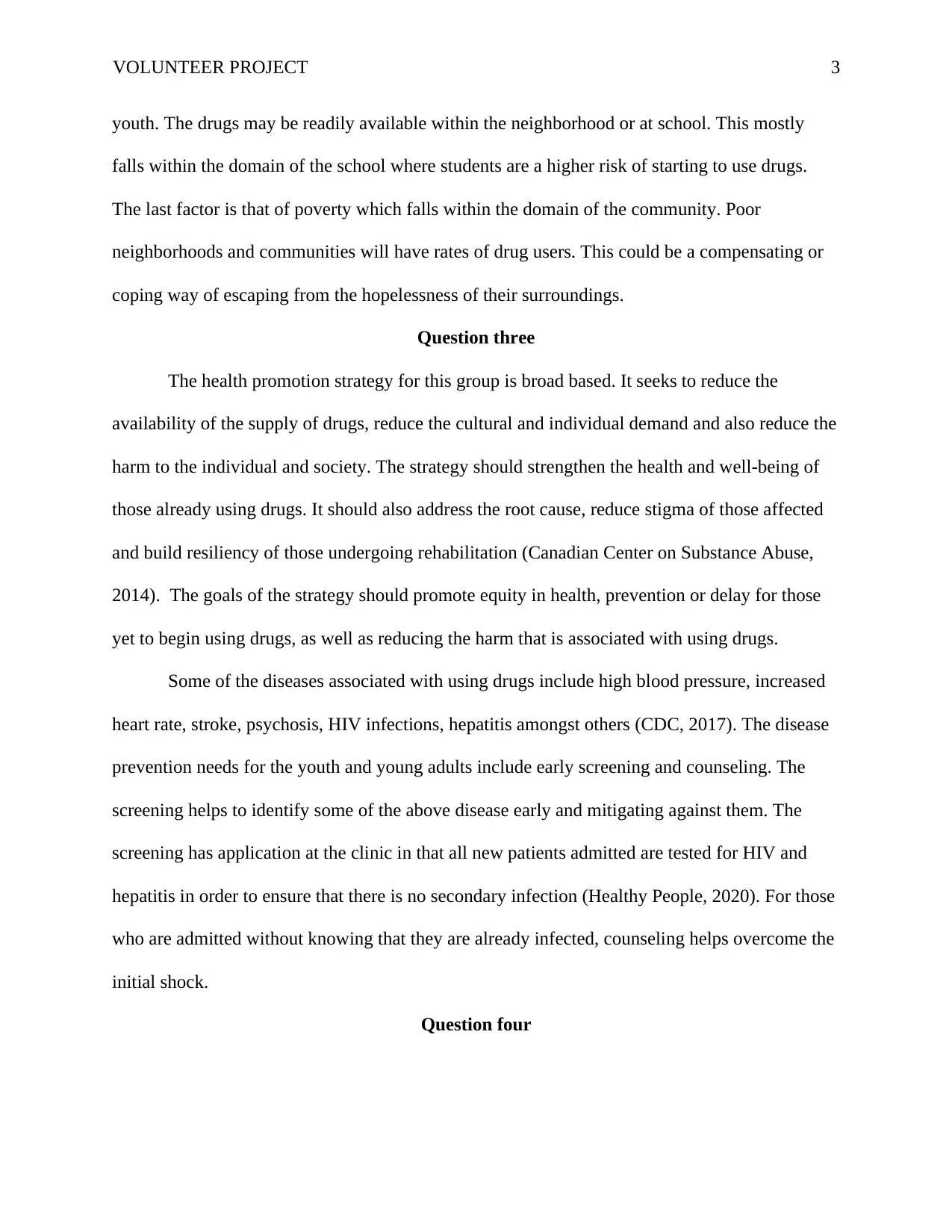
VOLUNTEER PROJECT 3
youth. The drugs may be readily available within the neighborhood or at school. This mostly
falls within the domain of the school where students are a higher risk of starting to use drugs.
The last factor is that of poverty which falls within the domain of the community. Poor
neighborhoods and communities will have rates of drug users. This could be a compensating or
coping way of escaping from the hopelessness of their surroundings.
Question three
The health promotion strategy for this group is broad based. It seeks to reduce the
availability of the supply of drugs, reduce the cultural and individual demand and also reduce the
harm to the individual and society. The strategy should strengthen the health and well-being of
those already using drugs. It should also address the root cause, reduce stigma of those affected
and build resiliency of those undergoing rehabilitation (Canadian Center on Substance Abuse,
2014). The goals of the strategy should promote equity in health, prevention or delay for those
yet to begin using drugs, as well as reducing the harm that is associated with using drugs.
Some of the diseases associated with using drugs include high blood pressure, increased
heart rate, stroke, psychosis, HIV infections, hepatitis amongst others (CDC, 2017). The disease
prevention needs for the youth and young adults include early screening and counseling. The
screening helps to identify some of the above disease early and mitigating against them. The
screening has application at the clinic in that all new patients admitted are tested for HIV and
hepatitis in order to ensure that there is no secondary infection (Healthy People, 2020). For those
who are admitted without knowing that they are already infected, counseling helps overcome the
initial shock.
Question four
youth. The drugs may be readily available within the neighborhood or at school. This mostly
falls within the domain of the school where students are a higher risk of starting to use drugs.
The last factor is that of poverty which falls within the domain of the community. Poor
neighborhoods and communities will have rates of drug users. This could be a compensating or
coping way of escaping from the hopelessness of their surroundings.
Question three
The health promotion strategy for this group is broad based. It seeks to reduce the
availability of the supply of drugs, reduce the cultural and individual demand and also reduce the
harm to the individual and society. The strategy should strengthen the health and well-being of
those already using drugs. It should also address the root cause, reduce stigma of those affected
and build resiliency of those undergoing rehabilitation (Canadian Center on Substance Abuse,
2014). The goals of the strategy should promote equity in health, prevention or delay for those
yet to begin using drugs, as well as reducing the harm that is associated with using drugs.
Some of the diseases associated with using drugs include high blood pressure, increased
heart rate, stroke, psychosis, HIV infections, hepatitis amongst others (CDC, 2017). The disease
prevention needs for the youth and young adults include early screening and counseling. The
screening helps to identify some of the above disease early and mitigating against them. The
screening has application at the clinic in that all new patients admitted are tested for HIV and
hepatitis in order to ensure that there is no secondary infection (Healthy People, 2020). For those
who are admitted without knowing that they are already infected, counseling helps overcome the
initial shock.
Question four
⊘ This is a preview!⊘
Do you want full access?
Subscribe today to unlock all pages.

Trusted by 1+ million students worldwide
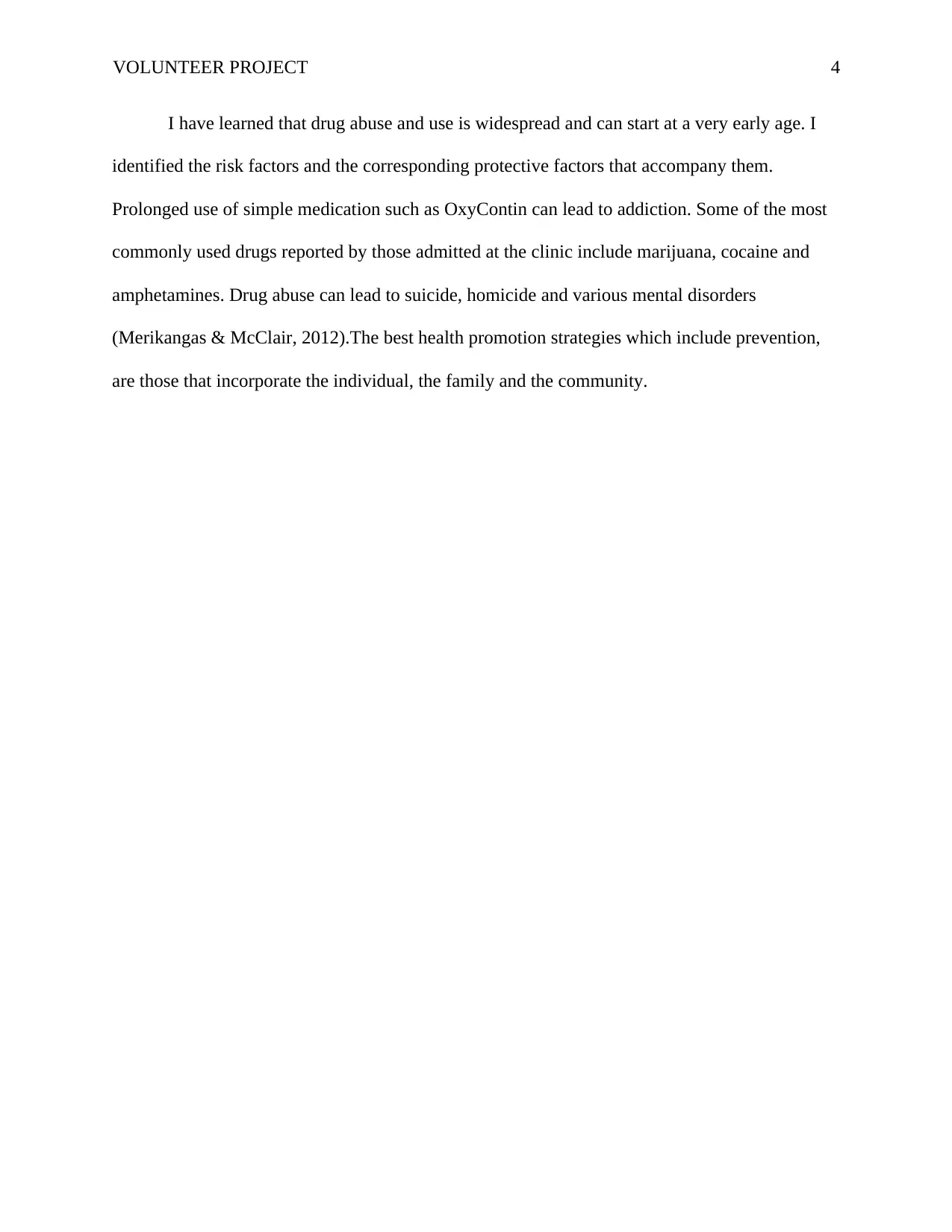
VOLUNTEER PROJECT 4
I have learned that drug abuse and use is widespread and can start at a very early age. I
identified the risk factors and the corresponding protective factors that accompany them.
Prolonged use of simple medication such as OxyContin can lead to addiction. Some of the most
commonly used drugs reported by those admitted at the clinic include marijuana, cocaine and
amphetamines. Drug abuse can lead to suicide, homicide and various mental disorders
(Merikangas & McClair, 2012).The best health promotion strategies which include prevention,
are those that incorporate the individual, the family and the community.
I have learned that drug abuse and use is widespread and can start at a very early age. I
identified the risk factors and the corresponding protective factors that accompany them.
Prolonged use of simple medication such as OxyContin can lead to addiction. Some of the most
commonly used drugs reported by those admitted at the clinic include marijuana, cocaine and
amphetamines. Drug abuse can lead to suicide, homicide and various mental disorders
(Merikangas & McClair, 2012).The best health promotion strategies which include prevention,
are those that incorporate the individual, the family and the community.
Paraphrase This Document
Need a fresh take? Get an instant paraphrase of this document with our AI Paraphraser
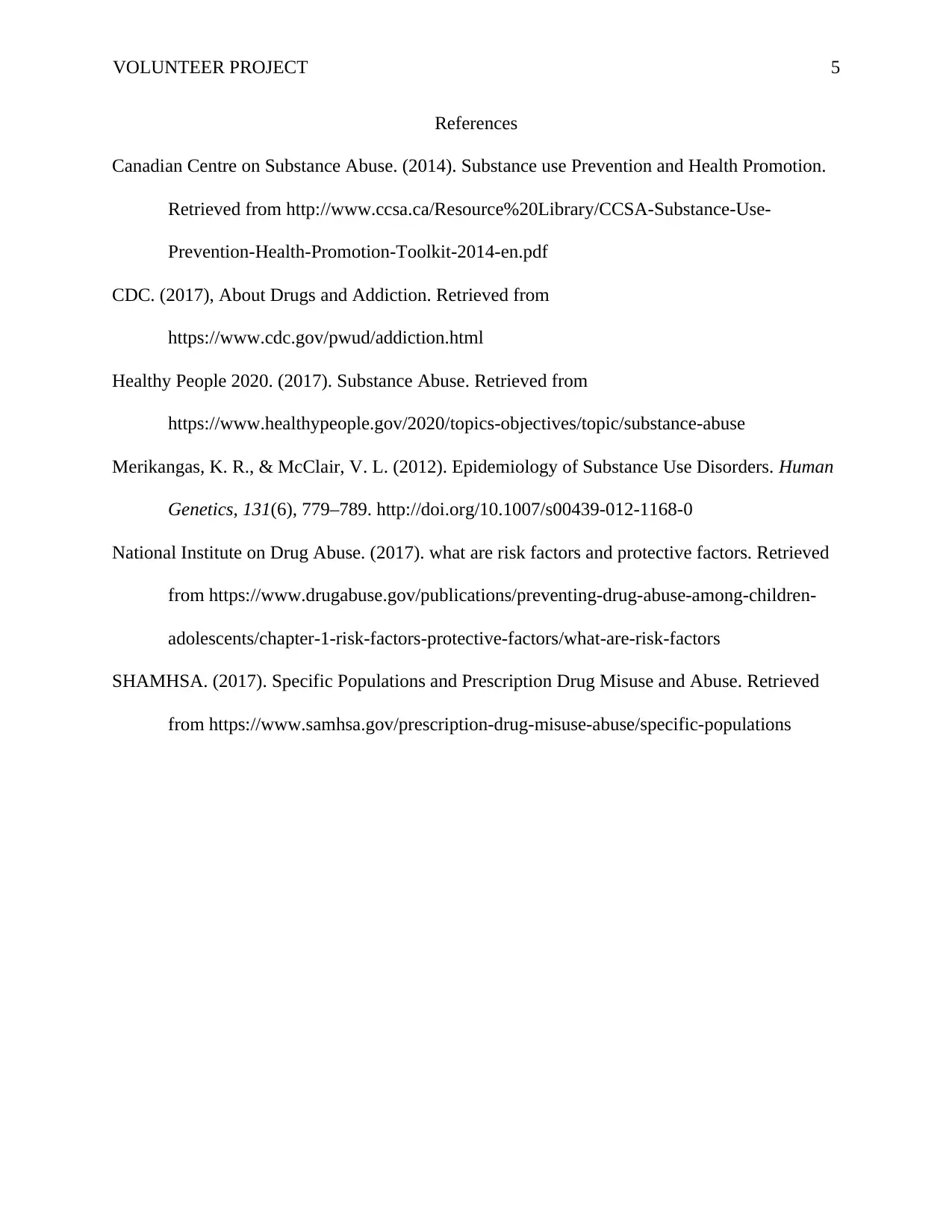
VOLUNTEER PROJECT 5
References
Canadian Centre on Substance Abuse. (2014). Substance use Prevention and Health Promotion.
Retrieved from http://www.ccsa.ca/Resource%20Library/CCSA-Substance-Use-
Prevention-Health-Promotion-Toolkit-2014-en.pdf
CDC. (2017), About Drugs and Addiction. Retrieved from
https://www.cdc.gov/pwud/addiction.html
Healthy People 2020. (2017). Substance Abuse. Retrieved from
https://www.healthypeople.gov/2020/topics-objectives/topic/substance-abuse
Merikangas, K. R., & McClair, V. L. (2012). Epidemiology of Substance Use Disorders. Human
Genetics, 131(6), 779–789. http://doi.org/10.1007/s00439-012-1168-0
National Institute on Drug Abuse. (2017). what are risk factors and protective factors. Retrieved
from https://www.drugabuse.gov/publications/preventing-drug-abuse-among-children-
adolescents/chapter-1-risk-factors-protective-factors/what-are-risk-factors
SHAMHSA. (2017). Specific Populations and Prescription Drug Misuse and Abuse. Retrieved
from https://www.samhsa.gov/prescription-drug-misuse-abuse/specific-populations
References
Canadian Centre on Substance Abuse. (2014). Substance use Prevention and Health Promotion.
Retrieved from http://www.ccsa.ca/Resource%20Library/CCSA-Substance-Use-
Prevention-Health-Promotion-Toolkit-2014-en.pdf
CDC. (2017), About Drugs and Addiction. Retrieved from
https://www.cdc.gov/pwud/addiction.html
Healthy People 2020. (2017). Substance Abuse. Retrieved from
https://www.healthypeople.gov/2020/topics-objectives/topic/substance-abuse
Merikangas, K. R., & McClair, V. L. (2012). Epidemiology of Substance Use Disorders. Human
Genetics, 131(6), 779–789. http://doi.org/10.1007/s00439-012-1168-0
National Institute on Drug Abuse. (2017). what are risk factors and protective factors. Retrieved
from https://www.drugabuse.gov/publications/preventing-drug-abuse-among-children-
adolescents/chapter-1-risk-factors-protective-factors/what-are-risk-factors
SHAMHSA. (2017). Specific Populations and Prescription Drug Misuse and Abuse. Retrieved
from https://www.samhsa.gov/prescription-drug-misuse-abuse/specific-populations
1 out of 5
Related Documents
Your All-in-One AI-Powered Toolkit for Academic Success.
+13062052269
info@desklib.com
Available 24*7 on WhatsApp / Email
![[object Object]](/_next/static/media/star-bottom.7253800d.svg)
Unlock your academic potential
Copyright © 2020–2025 A2Z Services. All Rights Reserved. Developed and managed by ZUCOL.




